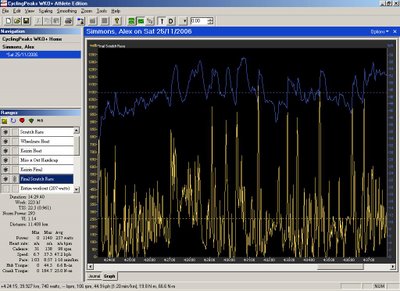More on Team Pursuiting...
In the first couple of weeks it was about familiarity with each other's wheel (and each other for the newer club member) and riding in formation/pursuit bike set up. Then the pace of our efforts was lifted and rider order changed about to find out individual rider's form and to iron out technique and pacing.
Three weeks out from the event the sessions were:
Sunday morning: After a warm up, 2 x standing starts, maximum of 1.5km (often less than 1km) - just enough to have everyone do one (maybe two) short turn(s) on the front and get the start pacing right. Then the boys could do what they liked (starts/sprints etc). I'd already done my endurance training beforehand so that would be it for me.
Monday night at race venue: After a warm up, 2 x Flys at or near race pace: 1 x 2.5-3km just under race pace as an opener; 1 x 2km at race pace. This served to reinforce technique at full pace and provide confidence to team members since a 2km fly is significantly easier than a full pursuit effort. Indeed, I specifically avoided doing a full pursuit effort.
(a) select riders to make the first choice team,
(b) decide on the rider order and
(ii) more than half the training sessions were conducted on a 333 metre velodrome and not the 250 metre track we would race on
(iii) I could match what actually happened with the PM data (e.g. did a rider slow down because they were slow or because the rider before them was going too fast). Retrospective analysis of PM data helped keep objectivity in the decisions.
Final week efforts were done in race order and full race kit used for flys at race venue in final two weeks to make sure everything was tested OK.
Team BalanceWe had a mix of track pursuit/enduro and track TT riders with different levels of experience of the event (from 10 years of team pursuiting to second attempt), so blending the unique characteristics of each to maximise team potential is an interesting exercise. I certainly learned never to start with a TTr, they go out way too hard (can't help themselves).
We were fortunate to have five guys going well enough to ride so we had a reserve rider on the day in case we needed him. Most of the guys were training right through this event as our goals are more the Masters track championships in March. I certainly hadn't done anything special to taper for it, indeed I was doing VO2 Max work and raced a hardish crit in the days leading up. In fact, my Sunday training sessions above were preceded by a 80-100 min of high end tempo (L3) in a 3 hour ride and the Monday flys were my "rest day". Despite this, my TSB remained in a relatively neutral zone.
Result: A State Championship win.






























